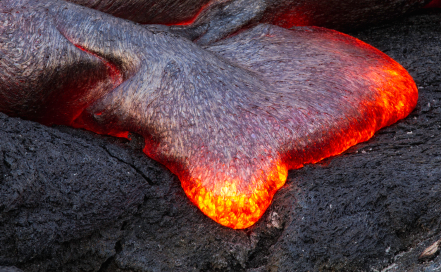Mystery of Isotope Separation in Lava is Solved
Different isotopes of an element behave almost identically, but surprisingly, within matter that is at uneven temperature, such as magma that is slowly solidifying, heavier isotopes diffuse faster than lighter ones. In Physical Review Letters, a team of physicists and earth scientists now explains why. Their experiments and computer simulations suggest that the heavier molecules and atoms use their slightly larger momentum to push past the light-weights when moving from hot regions to colder ones. The results may give new insights into the physics of magma and the rocks that form from it.
The notion that temperature variations may promote chemical differentiation in the Earth “has been knocked around since the late 1800s,” beginning with Swiss chemist Charles Soret, says Charles Lesher, a geologist from the University of California, Davis. For gases, the Soret effect (also called thermophoresis) was explained with a classical theory in the 1930s, and the phenomenon was even exploited for uranium enrichment in the Manhattan Project. But whether isotopes can spontaneously segregate in magma was not proven conclusively until the 1990s, and then only in laboratory experiments [1]. In molten rock, heavier isotopes of elements such as magnesium, calcium, or iron tend to congregate where it’s colder, whereas the lighter isotopes seem to prefer warmer regions. The difference in concentrations between the two is relatively small, however—typically less than one percent. “What has been sorely lacking in the geosciences,” Lesher says, “is an appreciation of why the effect occurs and how to predict the magnitude of the mass dependence.”
A paper published last year proposed that quantum effects cause the separation [2]. But Daniel Lacks, a physicist from Case Western Reserve University in Cleveland, Ohio, was already studying a possible classical explanation of the phenomenon, together with Lesher and other collaborators. First, the team ran isotope separation experiments for a series of elements. They used a wider range of elements than had been used before—including elements as heavy as hafnium and uranium—in order to improve their ability to compare theory with experiment. They exposed a sample of molten magnesium silicate containing small amounts of other elements to a temperature difference of more than 400degrees across a distance of 1 centimeter for longer than a month. After the sample solidified, the team sliced it up and found that heavier isotopes of most elements were roughly one percent more prevalent in the colder side than in the hotter side.
Next, the researchers used the 1930s theory—originally intended for gases—to predict the degree of isotope separation and found that it agreed with the data quite well. Finally, they performed computer simulations of molecules in the liquid, modeling them as classical particles, and again found good agreement with the data.
Although the microscopic behavior of a complex fluid such as magma is rather intricate, the physics behind isotope separation is ultimately simple, Lacks says. Imagine a crowded room of physicists that includes a few sumo wrestlers, and a fire breaks out on one side of the room. The room has no exit, but people will try to move to the colder side. “The sumo wrestlers are going to be able to push their way more easily,” says Lacks. In the case of atoms, different isotopes will have the same kinetic energies, on average, but heavier atoms will have more momentum. So these atoms, after colliding with lighter atoms, will tend to keep moving ahead, even if slowed down.
E. Bruce Watson, a geochemist at Rensselaer Polytechnic Institute, in Troy, New York, says the new result offers insight into a “growing body of data.” Lesher says isotope effects could shed light on the processes by which magma turns into rock. In particular, it could help geoscientists understand the mysterious thin layer of molten rock called the D′′ layer, which is located between Earth’s solid mantle and its liquid-iron core.
–Davide Castelvecchi
Davide Castelvecchi is a freelance science writer in Rome.
References
- T. K. Kyser, C. E. Lesher, and D. Walker, “The effects of liquid immiscibility and thermal diffusion on oxygen isotopes in silicate liquids,” Contrib. Mineral. Petr. 133, 373 (1998)
- G. Dominguez, G. Wilkins, and M. H. Thiemens, “The Soret effect and isotopic fractionation in high-temperature silicate melts,” Nature 473, 70 (2011)





